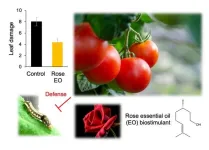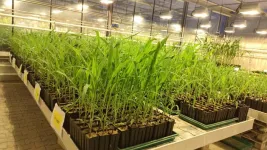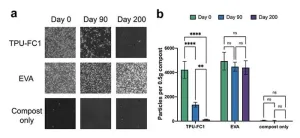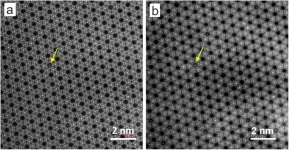Rose essential oil: A safe pesticide for organic agriculture
Researchers find that rose essential oil activates tomato defense genes and attracts herbivore predators that protect the plants.
2024-03-21
(Press-News.org)
Plants-derived essential oils (EOs) find applications in various industries, such as detergents, cosmetics, pharmacology, and food additives. Moreover, EOs have an exceptional safety profile, and their numerous bioactivities greatly benefit human health. Beyond these benefits, EOs have also been found to illicit insect-repellent responses by inducing neurotoxic effects.
Terpenoids are abundant in plant EOs and have garnered widespread attention as they can regulate plant defense responses by regulating the expression of defense genes. For example, soybean and komatsuna plants, when grown near mint, experience a significant improvement in defense properties and become resistant to herbivores. This phenomenon occurs through a process known as “eavesdropping,” wherein volatile compounds are released from the mint plant. These volatile compounds trigger the activation of defense genes, protecting against potential herbivore threats.
Today, applying chemical pesticides is the method of choice for crop protection, but the damage they cause to the environment and ecosystems, along with the need to increase food productivity, stresses the need for safer alternatives. Thus, there is an urgent need for investigation of plant defense potentiators. In this regard, the availability of EOs makes them attractive candidates as environmentally friendly plant defense activators. However, there is a lack of sufficient proven examples to meet the demand.
To address this, a research team led by Professor Gen-ichiro Arimura from the Department of Biological Science and Technology at the Tokyo University of Science (TUS) assessed the efficacy of 11 EOs in activating tomato defense responses. “EOs used as fragrances for various purposes contain odor components, which may have the ability to work like volatile compounds in conferring pest resistance. We aimed to investigate the effects of these EOs on plants’ insect pest resistance,” says Prof. Arimura. The team’s findings were published in the Journal of Agricultural and Food Chemistry on March 18, 2024.
The team profiled the effects of terpenoid-enriched EOs on tomato plants. They applied ethanol-diluted solutions of 11 different EOs to the soil of potted tomato plants, performed molecular analyses to study the gene expression inside leaf tissue, and observed that rose EO (REO) increased the transcript levels of PIR1 and PIN2, the genes involved in plant defense. Additionally, tomato plants treated with REO exhibited reduced leaf damage caused by the Spodoptera litura (a moth species) larvae and Tetranychus urticae (a mite pest). Furthermore, to explore the possibility of broader application, the researchers conducted a field experiment to measure REO activity in field conditions. They observed a 45.5% reduction in tomato pest damage compared to the control solution. The researchers believe that REO could serve as a viable alternative to pesticides during the winter and spring seasons when pest infestation is less severe and could potentially reduce pesticide usage by almost 50% during summers.
Explaining the research findings, Prof. Arimura says, “REO is rich in β-citronellol, a recognized insect repellent, which enhances REO's efficacy. Owing to this, damage caused by the moth larvae and mites was significantly minimized, confirming REO as an effective biostimulant. The findings also showed that a low concentration of REO did not repel T. urticae but attracted Phytoseiulus persimilis, a predator of these spider mites, thus exhibiting a dual function of REO.”
Overall, the study highlights the role of β-citronellol-enriched EO in activating defense genes in tomato leaves. Additionally, it provides evidence that REO is an effective biostimulant for enhancing plant defense against pests, which is also safe as it does not lead to phytotoxicity or leave any toxic residues behind. “Our study suggests a practical approach to promoting organic tomato production that encourages environmentally friendly and sustainable practices. This research may open doors for new organic farming systems. The dawn of potent environmentally friendly and natural pesticides is upon us,” concludes Prof. Arimura.
***
Reference
DOI: https://doi.org/10.1021/acs.jafc.3c08905
About The Tokyo University of Science
Tokyo University of Science (TUS) is a well-known and respected university, and the largest science-specialized private research university in Japan, with four campuses in central Tokyo and its suburbs and in Hokkaido. Established in 1881, the university has continually contributed to Japan's development in science through inculcating the love for science in researchers, technicians, and educators.
With a mission of “Creating science and technology for the harmonious development of nature, human beings, and society," TUS has undertaken a wide range of research from basic to applied science. TUS has embraced a multidisciplinary approach to research and undertaken intensive study in some of today's most vital fields. TUS is a meritocracy where the best in science is recognized and nurtured. It is the only private university in Japan that has produced a Nobel Prize winner and the only private university in Asia to produce Nobel Prize winners within the natural sciences field.
Website: https://www.tus.ac.jp/en/mediarelations/
About Professor Gen-ichiro Arimura from Tokyo University of Science
Dr. Gen-ichiro Arimura is a Professor in the Department of Biological Science and Technology at the Tokyo University of Science, Japan. Prof. Arimura earned a Ph.D. in 1998 from the Hiroshima University Graduate School, Japan. He researches the molecular mechanisms of plant-insect interactions and the biotechnology applications of plant scents in inter-organism communication. He has published over 100 peer-reviewed papers since 1996.
END
ELSE PRESS RELEASES FROM THIS DATE:
2024-03-21
Contact:
Jillian McKoy, jpmckoy@bu.edu
Michael Saunders, msaunder@bu.edu
##
Identifying genetic variants and the role they play in predisposing people to Alzheimer’s disease can help researchers better understand how to treat the neurodegenerative condition for which there is currently no cure. A new study led by Boston University School of Public Health (BUSPH) and UTHealth Houston School of Public Health has identified several genetic variants that may influence Alzheimer’s disease risk, putting researchers one step closer to uncovering biological pathways to target for future treatment and prevention.
Published in the journal Alzheimer’s ...
2024-03-21
In order for plants to grow, they absorb water and nutrients through their roots. In doing so, they rely on tiny helpers: bacteria and fungi in particular are found in a thin layer around the roots. These microbes also ward off organisms that are harmful to the plant, just as the "microbiome" in the human gut helps determine whether we fall ill or stay healthy.
An international research team led by the University of Bonn and with the participation of the IPK Leibniz Institute has now demonstrated on maize plants that the genetic make-up of the host plant has a significant influence on the composition of the root microbes. "It was shown ...
2024-03-21
Reduced snow cover and shifting vegetation patterns in the Alps, both driven by climate change, are having major combined impacts on biodiversity and functioning of ecosystems in the high mountains, according to new research published today.
Mountain ranges covering vast areas of the world are warming much faster than surrounding lowland areas, triggering huge reductions in snow cover and rapid upward movement of dwarf-shrubs, such as heather.
Scientists at The University of Manchester have found that these changes are disrupting the timing of crucial alpine ecosystem functions performed by ...
2024-03-21
Microplastics are tiny, nearly indestructible fragments shed from everyday plastic products. As we learn more about microplastics, the news keeps getting worse. Already well-documented in our oceans and soil, we’re now discovering them in the unlikeliest of places: our arteries, lungs and even placentas. Microplastics can take anywhere from 100 to 1,000 years to break down and, in the meantime, our planet and bodies are becoming more polluted with these materials every day.
Finding viable alternatives to traditional petroleum-based plastics and microplastics has never been more important. New research from scientists ...
2024-03-21
In addition to their main components, the properties of crystalline and nanoporous materials often depend crucially on guest atoms or ions that are embedded in the tiny pores of their lattice structure. This applies to high-tech materials used in sensor or separation technology as well as to natural materials. The bluish gemstone aquamarine, for example, would be colourless without such guest components. Determining the type and position of guest components is difficult, as many materials react sensitively to the radiation emissions ...
2024-03-21
Acute myeloid leukemia (AML) is an aggressive form of blood cancer. It is caused by mutations in a large number of genes that are acquired in the course of a person’s life. One of these genes – the tumor suppressor gene TP53 – plays a key role. Normally, TP53 helps to prevent the development of tumors. Blood cancer patients in whom this gene is mutated, however, face an extremely poor prognosis, as their genes are resistant to conventional chemotherapeutic agents. Intensive research is therefore being carried out into new therapeutic approaches, ...
2024-03-21
The worry of gaining weight is a common excuse for smokers not to quit. A new study published today in the scientific journal Addiction has found that both starting smoking and lifetime smoking may increase abdominal fat, especially visceral fat: the unhealthy fat deep inside the abdomen that is linked to a higher risk of heart disease, diabetes, stroke, and dementia.
Smokers tend to have lower body weights than non-smokers, but they also have more abdominal fat, and more abdominal visceral fat. Visceral fat is hard to see; you can have ...
2024-03-21
A cross-disciplinary University of Waterloo team has developed a new contact lens material that could act as a bandage for corneal wounds while releasing drugs in a controlled manner to help the eye heal faster.
Typically, corneal abrasion patients spend seven to 10 days wearing a clear, oxygen-permeable bandage contact lens, often instilled with eyedrops containing antibiotics. However, the one-time antibiotic application makes it difficult to ensure enough drugs stay on the eye for sustained treatment.
“It’s a targeted-release drug delivery ...
2024-03-21
High temperatures during critical periods of the reproductive cycle of sheep result in 2.1 million fewer lambs produced in Australia each year, costing sheep farmers an estimated $97 million annually.
The work, funded by Meat and Livestock Australia and conducted by a transdisciplinary team of researchers from the University of Adelaide and South Australian Research Development Institute (SARDI), found that days above 32°C during the week of mating caused the significant loss of potential lambs.
Published in Nature Food, the study found annual losses of potential lambs would increase to 2.5 million if median global warming increased ...
2024-03-21
This study was led by Professor Mingliang Xu (College of Agronomy and Biotechnology, China Agricultural University, Beijing, China). Through phylogenic analysis, the authors identified a gene encoding a calcium-dependent protein kinase, ZmCPK39, as a candidate gene for plant height regulation in maize. The function of ZmCPK39 in controlling plant height has been verified using gene editing technology. Compared to the wild-type ND101, knockout of ZmCPK39 significantly reduced plant height by 40%.
The authors further ...
LAST 30 PRESS RELEASES:
[Press-News.org] Rose essential oil: A safe pesticide for organic agriculture
Researchers find that rose essential oil activates tomato defense genes and attracts herbivore predators that protect the plants.









